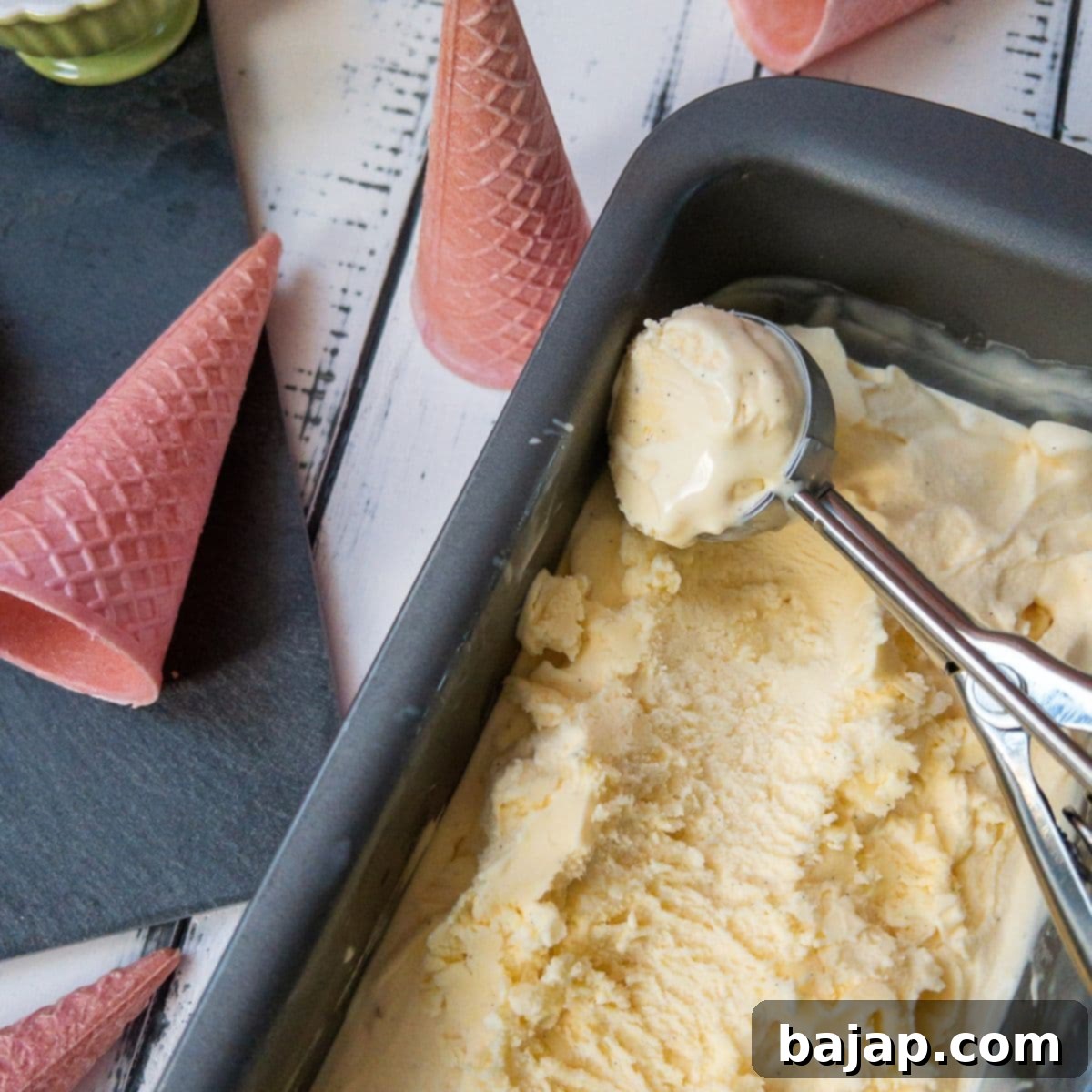Indulge in Creamy Perfection: The Ultimate Homemade KitchenAid Vanilla Ice Cream Recipe
Imagine a scoop of incredibly rich, smooth, and intensely flavored vanilla ice cream, made right in your own kitchen. There’s truly nothing quite like homemade ice cream, especially on a warm day or when you’re craving a classic sweet treat. This recipe isn’t just any homemade vanilla ice cream – it’s arguably the best you’ll ever taste, and it’s made effortlessly with your KitchenAid stand mixer and ice cream attachment!
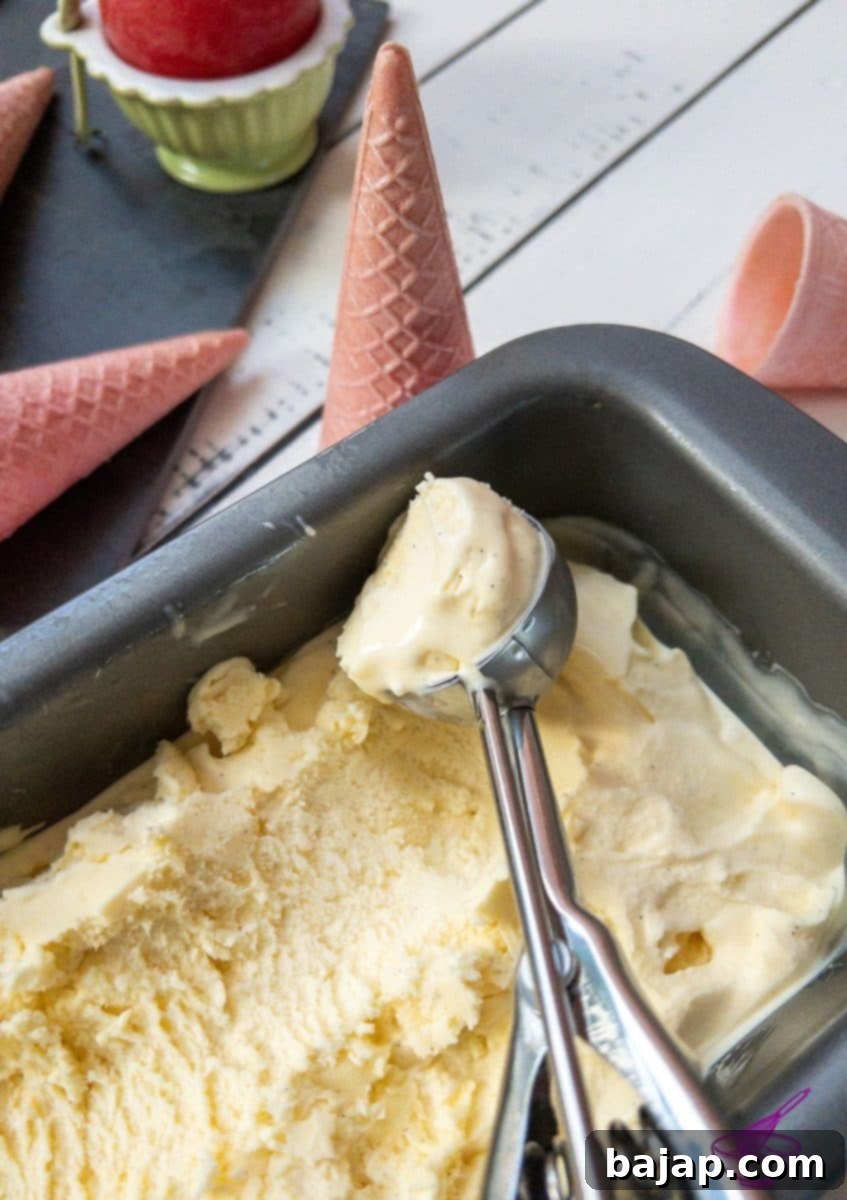
This fantastic KitchenAid vanilla ice cream recipe is a handy basic that not only delivers an unparalleled vanilla experience but also serves as an excellent base for countless other flavors. With this copycat recipe, you’ll be creating gourmet-quality desserts that rival your favorite ice cream parlor.
Why You’ll Adore This KitchenAid Vanilla Ice Cream
Prepare to fall in love with this vanilla ice cream for a multitude of reasons:
- Effortless Preparation: Thanks to your KitchenAid Ice Cream Maker Attachment, the churning process is simple and hands-off, allowing you to focus on developing the perfect custard base.
- Unbelievable Creaminess: This recipe yields a velvety smooth texture that melts deliciously in your mouth, free from the icy crystals often found in store-bought options. The high fat content from quality dairy and egg yolks is key to this luxurious consistency.
- Distinctly Intense Vanilla Flavor: By using a fresh vanilla bean, you unlock a depth of flavor that vanilla extract simply cannot match. Those tiny black specks are a testament to its authentic, aromatic goodness.
- Allergy-Friendly Goodness: A joy for many, this gelato is naturally fructose-free and gluten-free, making it a delightful dessert option for those with specific dietary needs without compromising on taste.
- Versatile Culinary Staple: Once you have a batch of this delicious ice cream at home, the possibilities are endless! It’s not just a standalone treat but a versatile ingredient to elevate other desserts.
Consider these delightful ways to enjoy your homemade vanilla ice cream:
- Spoon it into a classic sundae with freshly whipped cream and a drizzle of rich chocolate sauce.
- Blend it into a refreshing iced coffee or an indulgent affogato for a delightful pick-me-up.
- Create a thick, creamy milkshake by blending it with milk and your favorite mix-ins.
- Use it as a luxurious filling for traditional Austrian ice cream pancakes (Palatschinken) or between warm cookies for gourmet ice cream sandwiches.
- Pair it with warm fruit crumbles, pies, or brownies for an ultimate dessert experience.
🥘 Ingredients for KitchenAid Vanilla Ice Cream
Crafting this exceptional vanilla ice cream requires a few simple, high-quality ingredients. The key to its rich flavor and creamy texture lies in choosing the best:
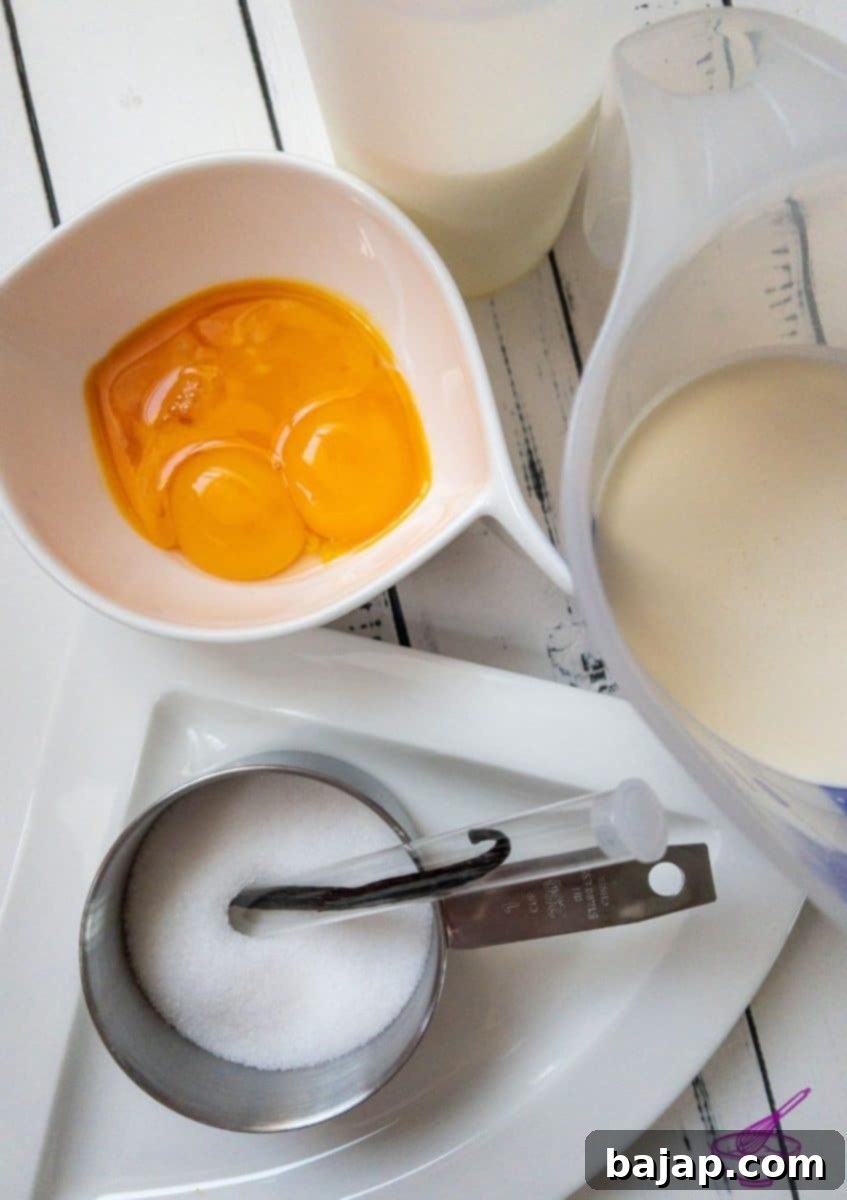
- Vanilla Bean (Fresh): This is the star of the show. Using a fresh vanilla bean provides a deep, complex, and natural vanilla flavor and those beautiful characteristic specks. Using vanilla extract is highly not recommended in this recipe as it won’t yield the same intense flavor profile and creamy result.
- Milk (High Percentage of Fat): Whole milk is crucial here. The fat content contributes significantly to the creamy texture and rich mouthfeel, helping to prevent ice crystals from forming.
- Egg Yolks: These form the base of our custard, adding richness, body, and a lovely golden hue to the ice cream. They also act as an emulsifier, contributing to the smooth texture. Don’t discard the leftover egg whites! Save or freeze them for future baking projects like light and airy cakes, delicate cookies, or a show-stopping pavlova!
- Granulated Sugar: Provides sweetness, but also plays a vital role in the texture by lowering the freezing point of the mixture, resulting in a softer, more scoopable ice cream.
- Heavy Cream: The backbone of any truly decadent ice cream. Opt for heavy cream with the highest fat percentage you can find. Please don’t use a low-fat alternative; the fat is essential for achieving that luxurious, creamy consistency.
For precise quantities, please refer to the detailed recipe card below.
🔪 Instructions for Homemade Vanilla Ice Cream
Making this incredible vanilla ice cream is a process of careful steps, resulting in a perfectly balanced and creamy dessert. Follow these detailed instructions for success:
Step 1: Infusing the Vanilla Milk
Begin by preparing your vanilla bean. On a cutting board, take a sharp knife and carefully slice the vanilla bean lengthwise down the middle. Using the back of your knife, gently scrape out the tiny, aromatic seeds (often called vanilla caviar). Both the seeds and the scraped pod are packed with flavor.
Place both the vanilla seeds and the empty pod into a small saucepan. Pour in the milk. This step is crucial for deeply infusing the milk with pure vanilla essence.
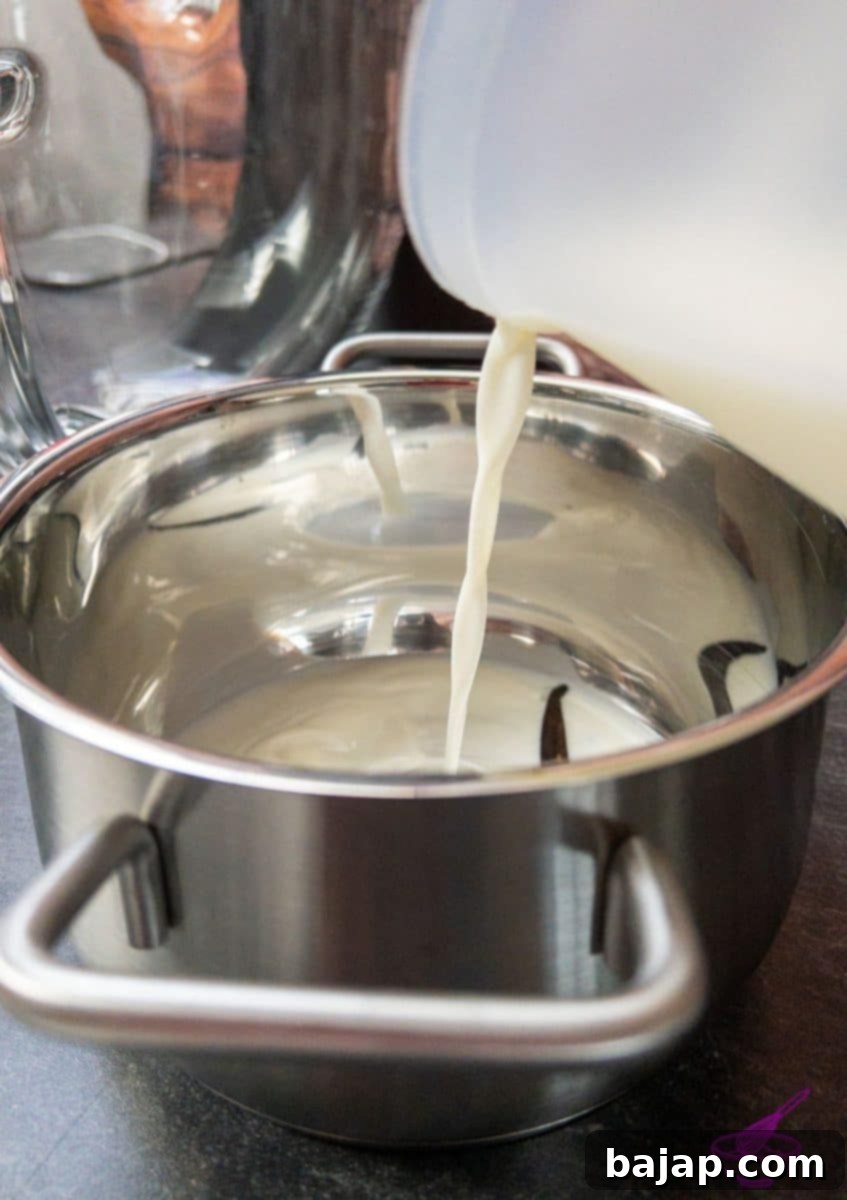
Gently bring the vanilla milk mixture to a boil over medium heat. Keep a close eye on it, as milk can boil over quickly. The moment you see it come to a boil, immediately remove the pot from the stove. This quick boil helps to extract maximum flavor from the vanilla.
Cover the pot tightly with a pot lid or, if you don’t have one that fits perfectly, a small plate works just as well. Let the mixture sit and steep, covered, for a full 30 minutes. This allows the vanilla flavor to deepen and fully infuse into the milk.
Step 2: Preparing the Egg Mixture and Tempering
While your vanilla milk is steeping, prepare your egg mixture. Carefully separate the egg yolks from the whites. Remember to save or freeze any leftover egg whites; they can last up to 10 months in the freezer! You can use them later for delicious treats like Christmas cookies, fluffy egg white cakes, or a classic pavlova.
In the mixing bowl of your food processor or stand mixer (preferably a KitchenAid), combine the egg yolks and granulated sugar. Begin whisking on a medium speed (KitchenAid speed 6) until the mixture becomes visibly pale in color and thick in consistency. This process incorporates air and dissolves the sugar, creating a smooth base.
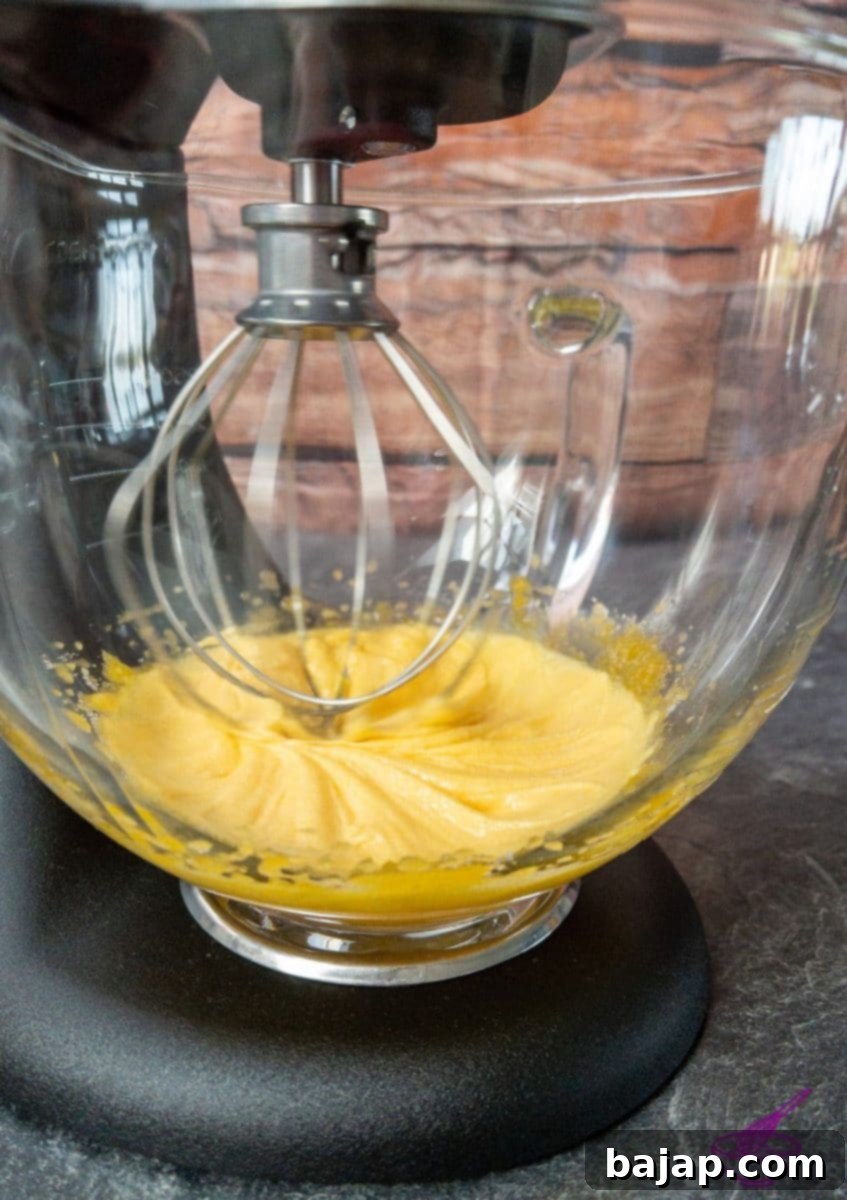
After the 30 minutes of steeping, bring the vanilla milk mixture back to a boil briefly, then immediately remove it from the heat. Carefully and slowly pour the hot milk into the egg yolk and sugar mixture in your mixing bowl while whisking continuously (KitchenAid speed 4). This crucial step is called “tempering.” It gradually raises the temperature of the egg yolks without scrambling them, ensuring a smooth custard base. Whip the combined mixture until it is completely smooth.
Step 3: Thickening and Cooling the Custard
Now, it’s time to thicken our vanilla cream. Rinse out the saucepan you used earlier for the milk mixture. Pour the smooth vanilla and egg mixture from your food processor back into this clean saucepan. This recipe involves a bit of back-and-forth, but each step contributes to the ultimate creamy texture.
Stir the mixture continuously over medium-low heat. The goal is to gently thicken the cream without bringing it to a boil, which could curdle the eggs. Continue stirring until the cream visibly thickens and coats the back of a wooden spoon, leaving a clear trail when you run your finger across it. This typically takes about 5-10 minutes. Be patient and keep stirring to prevent scorching.
Once the cream has reached this thick, custard-like consistency, immediately remove it from the heat. To ensure an ultra-smooth ice cream, strain the custard through a fine-mesh sieve into a sealable bowl. This step catches any tiny bits of cooked egg or vanilla pod remnants, guaranteeing a silky texture.
Cover the bowl tightly. You can use a dedicated lid or simply cover it with plastic wrap, pressing the wrap directly onto the surface of the custard. The purpose of covering it this way is to prevent a “skin” from forming as the mixture cools, which can affect the final texture. Set the covered mixture aside at room temperature for a short while, then transfer it to the refrigerator. It is absolutely essential to let the custard cool down entirely, preferably for at least 4 hours, or even better, overnight. A well-chilled custard will churn much more effectively.
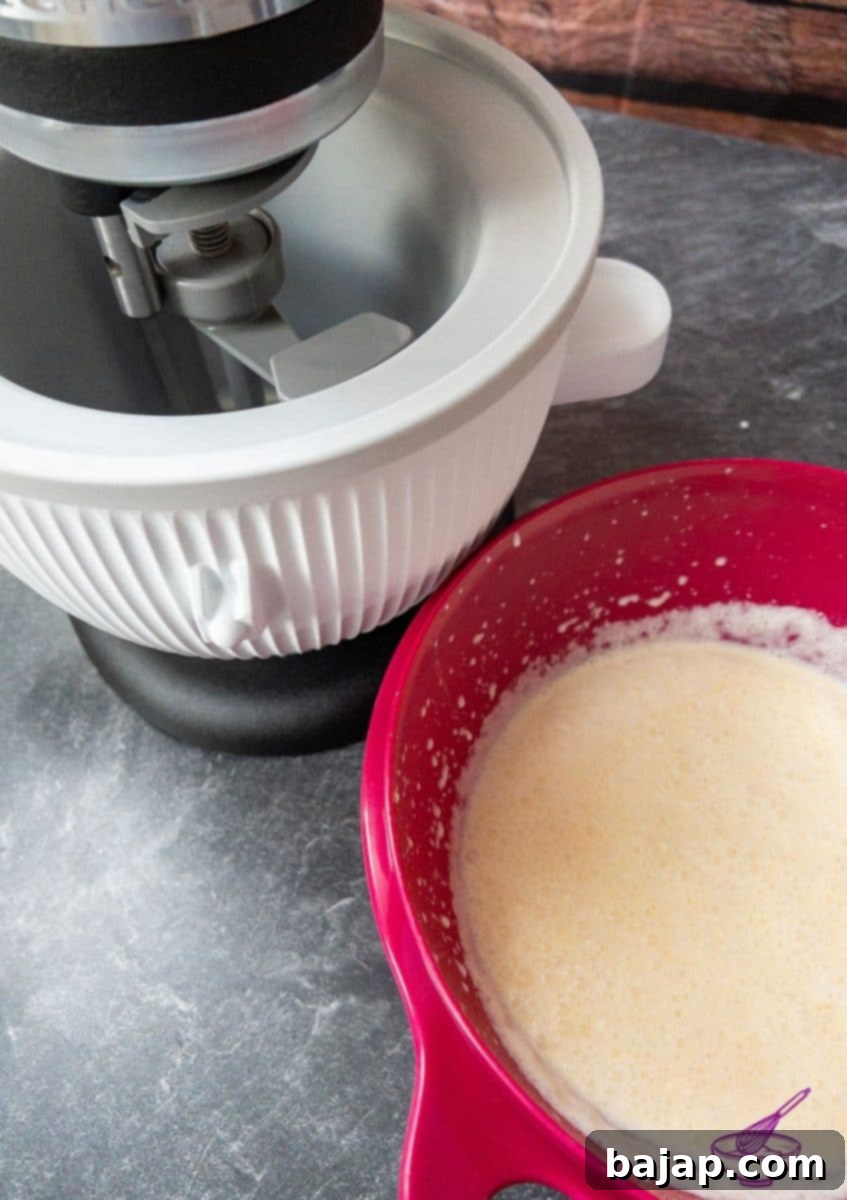
Step 4: Churning and Freezing for Perfection
Once the custard has cooled down completely and is thoroughly chilled, stir in the heavy cream. This adds the final touch of richness before churning. Now, it’s time to bring out your KitchenAid ice cream maker attachment.
Ensure your KitchenAid freezer bowl has been in the freezer for at least 15-24 hours (or as per your manufacturer’s instructions) and is completely frozen. Attach the frozen bowl to your KitchenAid machine and insert the dasher (the paddle that churns the ice cream). Once everything is properly assembled, you’re ready for the magic.
With the machine running on low speed (level 2), slowly pour the prepared ice cream batter into the freezer bowl. The dasher will begin to churn the mixture, gradually incorporating air and freezing it.
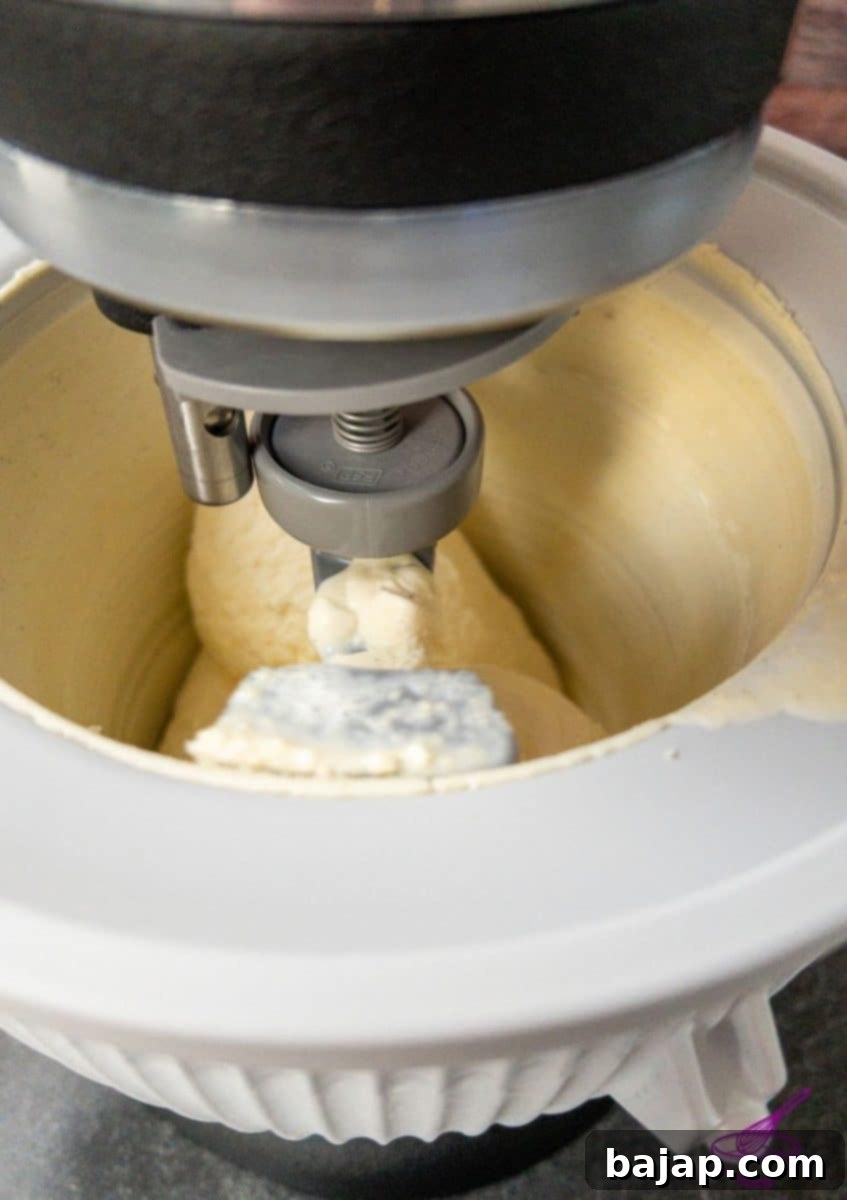
Allow the dasher to whip the cream for about 15-20 minutes, or until the mixture thickens to a soft-serve consistency. It will still be quite soft at this stage, but it should be significantly thicker than when you started. Once it reaches this point, turn off the machine.
Carefully transfer the churned vanilla ice cream into a freezer-safe container. For best results, choose a container that can be sealed tightly. Place it in the freezer overnight (at least 8 hours) to allow it to harden to a scoopable consistency.
Before serving the next day, for that perfect scoop, place the frozen container in the refrigerator for about 20 minutes. This will allow the ice cream to soften just enough to be easily scooped and enjoyed without being too hard.
Serve this delicacy in elegant sundaes with luscious chocolate sauce and clouds of whipped cream, or delight little gourmets with scoops in charming pink ice cream cones!
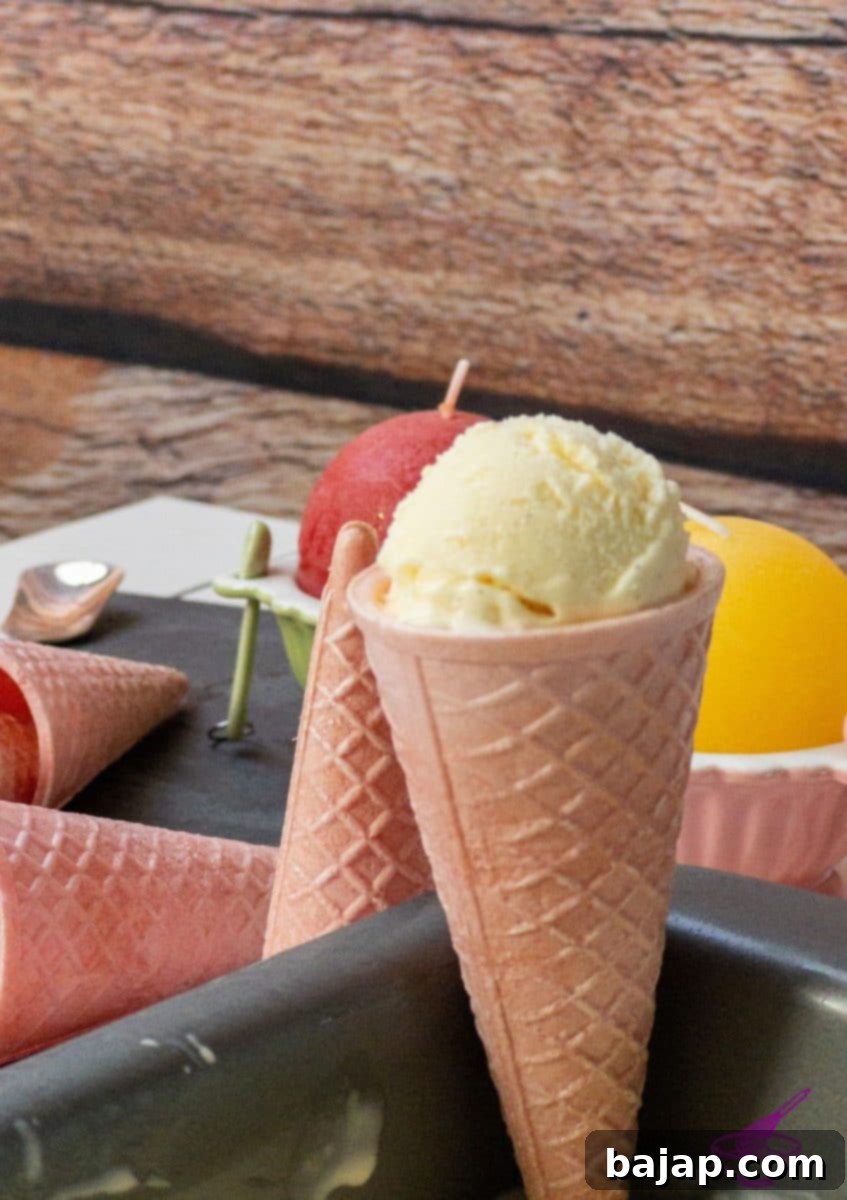
What an absolute treat! This homemade vanilla ice cream is so much better than anything you can buy in a store. Enjoy every delicious, creamy bite!
🍽 Essential Equipment
Having the right tools makes the process of crafting this perfect vanilla ice cream even smoother:
- Small Saucepan: For steeping the vanilla bean and preparing the custard.
- KitchenAid Stand Mixer: The powerful motor is ideal for whisking and churning.
- KitchenAid Ice Cream Attachment: The star appliance that transforms your custard into creamy ice cream. Ensure your freezer bowl is properly pre-chilled!
- Freezer-Safe Container: An airtight container is essential for storing your finished ice cream to prevent freezer burn. A loaf pan also works well, covered tightly with plastic wrap.
- Mixing Bowl with a Lid: Or a regular mixing bowl and cling film for covering – important for cooling the custard without forming a skin.
- Bowls: For separating the eggs.
- Mesh Strainer: To ensure a perfectly smooth custard by catching any cooked egg bits or vanilla pod fragments.
- Wooden Spoon: Ideal for stirring the custard over heat.
- Kitchen Knife: A sharp knife for splitting the vanilla bean.
- Cutting Board: For preparing the vanilla bean safely.
🌡️ Storage & Top Tips
🌡️ Storage
Since this rich ice cream uses fresh eggs, it’s best enjoyed within one to two weeks for optimal freshness and safety. Always store it in an airtight, freezer-safe container to protect its flavor and texture from freezer burn. For the best scoopability, remember to transfer it to the refrigerator for about 20 minutes before serving.
💭 Top Tip for Creamy Ice Cream
The Golden Rule of Ice Cream: Fat is Your Friend! When making ice cream, especially this rich vanilla version, it is absolutely crucial to avoid low-fat products. The higher the fat content in your milk and cream, the creamier and smoother your ice cream will be. Fat prevents the formation of large ice crystals, which are the enemy of creamy texture. Embrace full-fat dairy for the best results!
🍦 Flavor Variations for Your Homemade Ice Cream
While this vanilla ice cream is perfect on its own, its classic base makes it incredibly versatile for creating new flavors. Here are some ideas to inspire your next batch:
- Chocolate Chip: Stir in 1 cup of mini chocolate chips or finely chopped dark chocolate during the last 5 minutes of churning.
- Coffee/Espresso: Add 2 tablespoons of instant espresso powder (dissolved in a tiny bit of hot water) to the milk before steeping the vanilla.
- Mint Chocolate Chip: Add 1 teaspoon of pure mint extract (or to taste) to the cooled custard before churning, along with chocolate chips.
- Fruit Swirl: After churning to soft-serve consistency, gently fold in a swirl of homemade fruit compote (raspberry, strawberry, or blueberry) that has been cooled.
- Spiced Vanilla: Add a pinch of cinnamon, nutmeg, or cardamom to the milk mixture while steeping for a warm, aromatic twist.
- Lemon Zest: Add the zest of one lemon to the milk when steeping for a brighter, more aromatic vanilla.
Troubleshooting Common Ice Cream Issues
Even with the best recipes, sometimes things don’t go exactly as planned. Here are some solutions to common homemade ice cream problems:
- Icy Texture: This usually means there’s too much water and not enough fat or sugar. Ensure you’re using high-fat dairy and the correct amount of sugar. Also, ensure your freezer bowl is super cold and the custard is completely chilled before churning. Freezing too slowly can also cause ice crystals.
- Too Hard to Scoop: While a night in the freezer is necessary, if it’s rock-solid, you might have too much sugar (which lowers the freezing point) or not enough fat. Make sure to let it soften in the fridge for 15-20 minutes before serving.
- Grainy/Gritty Texture: This often happens if the sugar isn’t fully dissolved in the custard, or if the custard wasn’t strained. Make sure to whisk until the sugar is fully incorporated and always strain your custard.
- Not Freezing in the Machine: Your freezer bowl likely wasn’t cold enough. It needs to be frozen solid for at least 15-24 hours. The custard also needs to be thoroughly chilled.
🙋🏻 FAQ
Yes! You can easily double or even triple this recipe. Just make sure you have a large enough saucepan for the custard and enough freezer bowls for your KitchenAid attachment if you plan to churn multiple batches back-to-back.
Fresh vanilla beans offer a far more complex, intense, and nuanced flavor profile than vanilla extract. They also leave those beautiful black specks that signify authentic vanilla bean goodness. The subtle floral and woody notes from a real vanilla bean elevate the ice cream to a gourmet level that extract simply cannot achieve.
Don’t throw them away! Egg whites can be frozen for up to 10 months and are perfect for making meringues, pavlovas, macarons, angel food cake, or even simple egg white omelets. They’re a fantastic ingredient to repurpose!
If you make this irresistible recipe, please let me know how you liked it by giving it a ★★★★★ star rating and leaving a comment below. Your feedback means the world! You can also sign up for our Newsletter or follow me on Pinterest or Instagram and share your delightful creation with me. Just tag me @combinegoodflavors and use the hashtag #combinegoodflavors, so I don’t miss it. Happy churning!
📖 Recipe: Copycat KitchenAid Vanilla Ice Cream with Eggs
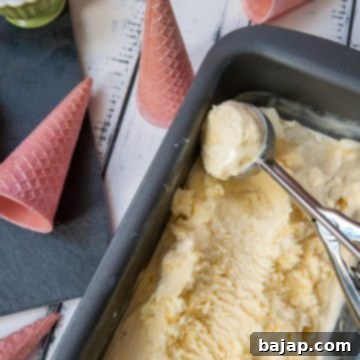
Copycat KitchenAid Vanilla Ice Cream with Eggs
Author: Nora
This remarkable homemade vanilla ice cream is quick and easy to prepare with your KitchenAid Ice Cream Maker Attachment! Its creamy consistency and distinctly intense, delightful vanilla flavor will make your heart beat faster!
Rated 4.99 from 96 votes
Print Recipe |
Pin Recipe
Prep Time: 40 mins
Cook Time: 15 mins
Freezing Time: 8 hrs
Total Time: 8 hrs 55 mins
Servings: 6 servings (Adjustable)
Calories: 305 kcal per serving
Course: Dessert, Ice Cream, Snack
Cuisine: European
Keywords: homemade vanilla ice cream, kitchenaid vanilla ice cream, kitchenaid vanilla ice cream recipe, kitchenaid vanilla ice cream recipe with eggs, vanilla ice cream
Equipment
- Small Saucepan
- KitchenAid Mixer
- KitchenAid Ice Cream Attachment
- Freezer safe container (can also be a loaf pan)
- Mixing bowl with a lid (or mixing bowl and cling film for covering)
- Mixing bowls (for separating the eggs)
- Mesh strainer
- Wooden spoon
- Kitchen knife
- Cutting Board
Ingredients
- 1 Vanilla bean (fresh – using vanilla extract is not recommended in this recipe)
- 1 ¼ cups Milk (with a high percentage of fat!)
- 4 Egg yolks
- ½ cups Granulated sugar
- 1 ¼ cups Heavy cream (with a high percentage of fat!)
Instructions
- Take a cutting board and a sharp knife and cut the vanilla bean lengthwise. Carefully scrape out the seeds.
- Then place the vanilla pulp and the pod in a small saucepan and pour in the milk.
- Bring the milk vanilla mixture to a boil! Remove the pot from the stove immediately as soon as the milk boils.
- Cover the pot with a pot lid or a small plate afterward.
- Now let the mixture sit and steep, covered, for 30 minutes.
- While the vanilla milk mixture is steeping, separate the eggs.
- In the mixing bowl of your food processor, add the egg yolks and granulated sugar and whisk until the mixture is pale and thick.
- Now bring the milk vanilla mixture back to a boil.
- Take it off the heat and pour it into the mixing bowl of your food processor.
- Whip the mixture until smooth (KitchenAid speed 4).
- Now rinse out the saucepan you used earlier and add the vanilla cream you prepared in the last step.
- Stir the mixture on medium-low heat until the cream thickens and sticks to the back of a wooden spoon.
- Once the cream has a thick consistency, pour it into a sealable bowl.
- Set the covered mixture aside and let it cool.
- Once the cream has cooled down entirely, stir in the heavy cream.
- Empty the prepared ice cream batter into the KitchenAid freezer bowl and switch to level 2.
- Let the dasher whip the prepared ice cream batter until the mixture is almost solid.
- Pour the vanilla ice into a freezer container.
- Please place it in the freezer overnight so that your vanilla ice is well chilled.
- Before serving the next day, please place it in the fridge for 20 minutes.
Never miss a recipe! Sign up and let me spoil you weekly with a delicious homemade recipe!
Nutrition values are estimates only, using online calculators. Please verify using your own data.
Serving: 1 serving | Calories: 305 kcal | Carbohydrates: 21g | Protein: 5g | Fat: 23g | Saturated Fat: 14g | Polyunsaturated Fat: 1g | Monounsaturated Fat: 6g | Cholesterol: 193mg | Sodium: 39mg | Potassium: 139mg | Sugar: 21g | Vitamin A: 996IU | Vitamin C: 1mg | Calcium: 112mg | Iron: 1mg
Like this recipe? Mention @combinegoodflavors or tag #combinegoodflavors!

🤎 You might also like
- Delicious 6 Egg White Chocolate Cake
- How to bake delicious Walnut Meringue Cookies
- Austrian Coconut “Busserl” cookies – like from granny
- Stracciatella egg liqueur milkshake recipe
⛑️ Food Safety Guidelines
Ensuring food safety is paramount when working with ingredients like raw eggs and dairy. Please follow these guidelines diligently:
- Always cook the custard to a minimum temperature of 165 °F (74 °C) to eliminate potential bacteria. Although we are careful not to boil, reaching this temperature during the thickening stage is important.
- Do not use the same utensils on cooked food that previously touched raw ingredients without thorough washing.
- Wash hands thoroughly with soap and water before and after handling raw eggs and dairy products.
- Do not leave the custard mixture or finished ice cream sitting out at room temperature for extended periods. Chill promptly and keep frozen.
- Never leave cooking food unattended, especially when heating milk and eggs, as they can scorch or curdle quickly.
- When cooking over heat, ensure you have good ventilation, especially when using a gas stove, to maintain good air quality.
For more comprehensive information on safe food handling and preparation, please refer to USDA.gov’s guidelines.
